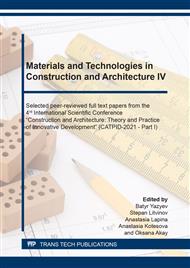p.1
p.9
p.15
p.27
p.37
p.43
p.49
p.55
Microfiller Influence on the Modified Cement Granulometric Composition
Abstract:
The aim of the work is to study the microfiller effect on the granulometric composition of the modified cement. A scanning electron microscope RМ-106 I was used for microscopic analysis. The survey was carried out in reflected electrons. The chemical analysis of the materials’ structure was investigated by energy dispersive spectroscopy (EDS). The distribution of particles of mineral components was evaluated with a Microsizer 201C laser particle analyzer with a range from 0.2 to 600 μm. Microscopic analysis of the samples of microsilica MK-85 shows that all particles are spherical with an average grain size of about 5 microns and consist of amorphous glass with a different set of particle fractions. The results of X-ray phase analysis of condensed microsilica grade MK-85 show that it consists mainly of silicon dioxide in an amorphous form. The introduction of mineral additives with a high specific surface in the composite Portland cements composition in an amount of more than 5% is not rational without the use of superplasticizers, since the water demand increases sharply, which reduces the cement stone strength. The introduction of a microfiller provides an increase in the compressive strength of a cement stone at the age of 28 days of normal hardening by an average of 37%.
Info:
Periodical:
Pages:
9-14
Citation:
Online since:
August 2021
Price:
Сopyright:
© 2021 Trans Tech Publications Ltd. All Rights Reserved
Share:
Citation:


